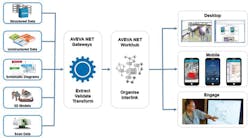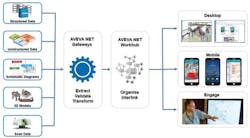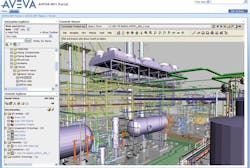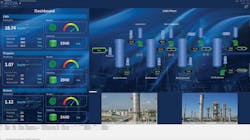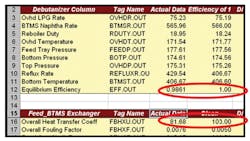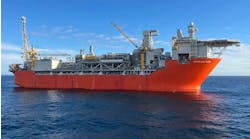Workflow becomes preventative not reactive
Eddy Lek, AVEVA
Oil priceshave swung sharply in recent months, fluctuating between $40/bbl to a high of almost $90/bbl. The unexpected price volatility is causing stress on the capex and opex of the oil and gas value chain. Compounding the challenges, the negative perception of fossil fuels, rising trade tensions and geopolitical upheaval are adversely affecting near-term demand and business costs.
As a result, more companies are looking toward a “digital transformation” to drive effective capacity, not only through capex, but also opex investments by optimizing operations and improving asset availability as these are more scalable and have a shorter lead time, enabling companies to swiftly respond to market changes.
A digital twin is a complete 360-degree replica of a physical asset such as pipelines, gathering systems, heat exchangers, turbines, pumps, compressors, or entire plants that enables modeling of process and control, and monitoring of equipment health. It is the foundation of a digital transformation that optimizes production, detects equipment problems before failures occur, uncovers new opportunities for process improvement, all while reducing unplanned downtime.
AVEVA NET gateways provide the interface to the source data.
(All images courtesy AVEVA)
The concept of a digital twin has been around for more than a decade. However, it is the advancement in technology in recent years – cloud computing, analytics, and increased computing power – plus greater clarity on the use cases that has accelerated the adoption of digital twins in industry.
From unprecedented real-time insights of their operations, to elevating their operational excellence to the next level, it is no wonder oil and gas companies are starting to realize the benefits that digital twins enable. For example, a 0.1% increase in production due to improved process and operating efficiency can easily yield several millions of dollars in additional revenue.
Information management system
At the AVEVA World Summit 2018, Amit Kah, Information Management Lead Advisor at Basrah Gas Company, spoke about its digital transformation journey and identified information management as the root of all challenges and opportunities of digital transformation1.
Lacking a robust information management system to maintain up-to-date critical information and operational data around assets during operations will incur significant waste on maintenance and operations budgets and resources to keep the assets running. Therefore, the key to achieving a digital twin is a comprehensive information management system that combines a centralized repository with enterprise-wide information access and visualization; one that allows users to have complete control of their asset information throughout the entire asset life.
To build a digital twin for an asset, an initial 3D model is created. This model is then tagged with all the necessary attributes and engineering documentation – such as geometry, layout, connectivity of key components and process data, and other business and safety-critical engineering and design information. Through a robust information gateway, information and data around the asset are extracted from disparate data sources and validated for accuracy against known standards to create viewable renditions of documents and drawings. This acts as a data validation layer to ensure that all data meet the correct standards throughout the asset lifecycle.
The digital twin delivers a 3D visualization of assets using a single, integrated source of up-to-date information.
Next, these common set of data and information are shared across departments – from engineering, to procurement, to construction, to commission, and to operations.
As the operational life continues, the digital copy is updated automatically, in real time, with current data, work records, and engineering information to optimize maintenance and operational activities. With this, engineers and operators can easily search the asset tags to access critical up-to-date engineering and work information and find the health of an asset.
Previously, such tasks would take considerable time and effort, and would often lead to issues being missed, leading to failures or production outages. With the digital twin, operational and asset issues are flagged and addressed early-on, and the workflow becomes preventative, instead of reactive.
Simulation and analytics
The reliable, real-time process data from the digital twin can be fed into simulation and analytics to optimize overall production, process conditions, and even predict failures ahead of time. The digital twin, when combined with powerful analytics and process simulations, enables predictive maintenance and optimal operations. Analytics leverage advanced pattern recognition, statistical models, and machine learning technology to model an asset’s operating profile and processes and predict future performance. Appropriate, timely actions are then recommended to reduce unplanned downtime and to optimize operating conditions. With the digital twin, process simulation using thermodynamic laws can also be performed on the models to optimize operating conditions based on their physical properties.
Analytics and process simulation have been used across offshore operations, from gathering systems to gas processing plants. Their benefits are discussed below.
Steady-state and dynamic simulation. At the front-end engineering design stage, steady-state simulation models of topsides gas processing, such as gas dehydration, mercury removal, gas sweetening, liquification, fractionation and others, can be created to optimize the design. Analytics can also be used to model fluid flow behaviors in pipeline multi-phase or single-phase flow to predict pipeline holdup and potential slugging in the network. During operations, engineers and operators can perform engineering studies to identify design changes that will significantly increase throughput, and the reliability and safety of plant operation. With a unified simulation platform, the evolution from a steady state to dynamic simulation can be achieved easily.
Dynamic simulation can be performed on these models to validate process design such as relief and flare systems, changes in feedstock, production capacity adjustment, and controls, enabling engineers to optimize design and reduce capex and opex. In addition, the dynamic simulation allows effective troubleshooting, control system checkouts, and comprehensive evaluations of standard and emergency operational procedures to shorten time requirements for safe plant start-up and shutdown. This forms the backbone of an Operator Training Simulator where operators can be trained on procedures to address real experiences in a safe and controlled classroom environment before they are deployed to offshore platforms. Major oil and gas operators have already reaped benefits using simulators as part of their enterprise-wide training programs, enabling them to reduce training costs and time to proficiency.
An operations management user interface.
Analytics to reduce process variability. Reducing process variability not only improves product quality, but also enables the process to be operated closer to its optimum points, reducing energy consumption, maximizing capacity, and improving product yield. Advanced process control (APC) has been used widely in gas processing plants to stabilize operations and reduce process variability due to varying feed gas rates, gas composition, and ambient temperature. APC is a multi-variable model predictive control and it adjusts the process conditions in real time to maximize process profits while maintaining the plant operations within the constraints. It has been successfully implemented in liquids recovery (cryogenic NGL recovery, condensate stabilization, NGL fractionation) and treating/sulfur recovery. Companies have seen increased yield of up to 2-3% in production and 2-5% saving in energy consumption. Other benefits include extended equipment life, reduced operator intervention, and consistent shift to shift performance.
Process performance monitoring. Heat exchangers handle complex heat transfer and are critical to production. Equipment efficiency and instrumentation accuracy should be monitored constantly as degradation of the heat exchanger can lead to inefficiencies and production slowdowns. Having an integrated model to monitor all rotating equipment, distillation towers and heat exchangers not only allows analysis of the interactions of various plant components, but also provides additional metrics on efficiency and utilization. Reconciliation of material, energy and equilibrium balances around a piece of equipment or entire plant can also identify bad instrument readings and pinpoint material and energy loss locations, effectively acting as a data validation layer. This is valuable information that cannot be measured directly, but is calculated based on first-principle, rigorous models that have been tuned to actual plant conditions.
Predictive analytics to monitor equipment health. Offshore platforms operate in locations exposed to extreme weather conditions, which means it often takes longer to restore back to full production rates after a planned or unplanned shutdown. Minimizing plant shutdowns is therefore key to improving production. This is where predictive analysis comes in.
Predictive analytics enables modeling of rotating equipment performance – such as pumps, compressors, and turbines – using advanced pattern recognition and machine learning algorithms to identify and diagnose any potential operating issues, days or weeks before failures occur. Operating models including past loading, ambient and operational conditions are used to create a unique asset signature for each type of equipment. Real-time operating data is then compared against these models to detect any subtle deviations from expected equipment behavior, allowing reliable and effective monitoring of different types of equipment with no programming required during setup. The early-warning notification allows reliability and maintenance teams to assess, identify and resolve problems, preventing major breakdowns that can cost companies millions of dollars in production slowdowns or stoppages.
Accurately estimating efficiencies and instrument drift is possible through performance monitoring via the digital twin.
Not just about technology
In a recent MIT Sloan Management Review article2, George Westerman said: “Technology doesn’t provide value to the business. Instead, technology’s value comes from doing business differently because technology makes it possible.”
Digital transformation allows companies to create new capabilities, new business models, and innovate ahead of their competition. It is a journey through deployment of information management systems, powerful analytics, automation of workflows and work orders, and driving behavioral change in workforce – changing when, where, which, and how work is performed and evolved.
Although digital transformation may seem like a daunting task to some, making the transition successfully can be profoundly rewarding for companies, since even slight improvements in asset utilization can result in huge gains in revenue and cashflow.
Conclusion
The digital twin framework enables operational excellence by helping oil and gas operators and owners take a model-focused approach that quickly turns massive amounts of data into wisdom that generates business value. These powerful data insights mean asset failure can be predicted, hidden revenue opportunities can be uncovered, and businesses can continuously improve in the ever-changing, competitive market. •
References
1. Amit Kar, ‘2 Speed Digitalization @ Basrah Gas Co – Projects and Handover’, AVEVA World Summit 2018, October 2018.
2. MIT Sloan Executive Education, Nov 2017. ‘Digital is not the answer—transformation is’. Retrieved from https://executive.mit.edu/blog/digital-is-not-the-answertransformation-is
The author
Eddy Lek,Industry Marketing Manager, AVEVA, is responsible for expanding awareness and marketing of its engineering and design, simulation, training, analytics and advanced control software in the oil and gas industry. He has more than 15 years of experience in product management, marketing and business development in process and industrial automation including controls, sensors, instrumentations and industrial software. He holds a Bachelor of Engineering from Nanyang Technological University and a Master’s in Business Administration from National University of Singapore.
